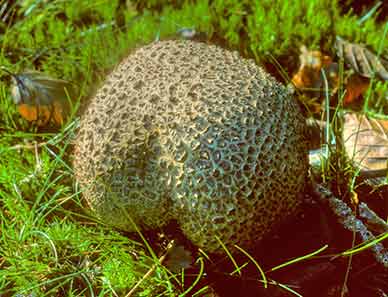Common Earthball (Scleroderma citrinum)

The Common Earthball, as with many other fungi, is a species that primarily appears in autumn, as the nights draw in and temperatures cool, but that is also encouraged by unseasonal levels of moisture to fruit in small numbers in summer.
Usually an inhabitant of moss-clad or grassy ground on acid soil under a variety of trees in woodland or on heathland, the Common Earthball, as the name suggests, is relatively common and widespread in the New Forest.
The usually browny-yellow but sometimes pale or cream-white, roundish, ball-shaped, inedible fruiting body appears to sit directly on the ground, to which it is attached by cord-like threads. Thick, tough and scaly, it can grow to a width of 12 centimetres, although the majority of specimens are somewhat smaller.
Huge numbers of tiny, dust-like brownish-black spores contained within the ball are released to be carried away on the breeze when, with age, the outer skin ruptures and splits.
Warning: refer to a good, comprehensive fungus field guide to confirm identification, and only eat those species known without any doubt whatsoever to be edible - people have died after eating certain poisonous specimens.
References:
Mushrooms and other Fungi of Great Britain and Europe - Roger Phillips
The Mushrooms and Toadstools of Britain and North-western Europe - Marcel Bon
Fungi of Britain and Europe - Stefan Buczacki and John Wilkinson
The MacDonald Encyclopedia of Mushrooms and Toadstools - Giovanni Pacioni
Fungi of the New Forest: A Mycota - Edited by Gordon Dickson and Ann Leonard
A Passion for Mushrooms - Antonio Carluccio
More links
Other related links
Search this site

Sadly, 58 animals were killed - 35 ponies, 13 cows, 8 donkeys and 2 sheep, whilst a further 32 were injured - 3 pigs, 9 donkeys, 11 cows and 9 ponies.
(Forty-three accidents occurred in daylight, 15 at twilight and 101 in the dark. Twenty-seven accidents were not reported by the driver involved).
Here's just one horrific example - Three donkeys killed in collision with van at notorious New Forest blackspot (Advertiser and Times)

